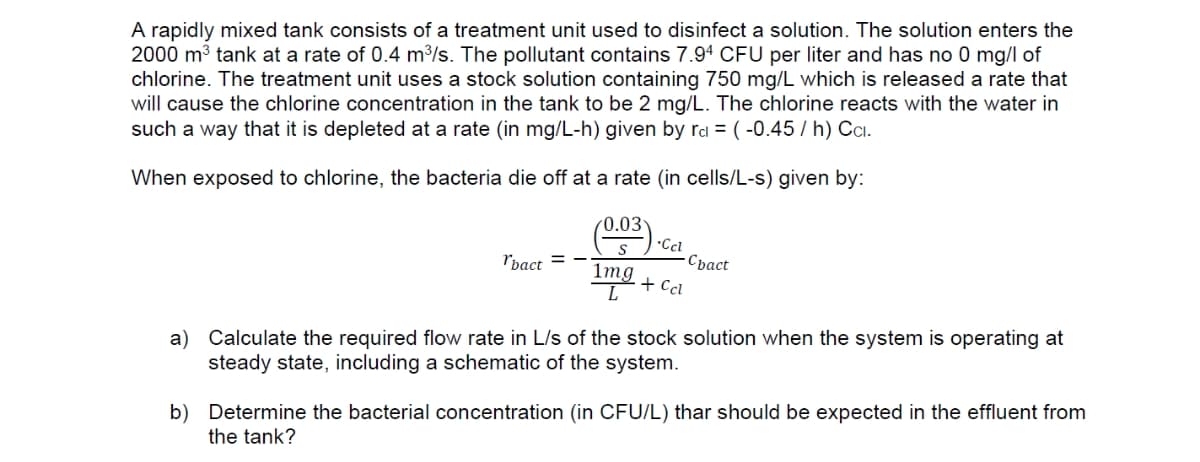A rapidly mixed tank consists of a treatment unit used to disinfect a solution. The solution enters the 2000 m3 tank at a rate of 0.4 m3/s. The pollutant contains 7.94 CFU per liter and has no 0 mg/l of chlorine. The treatment unit uses a stock solution containing 750 mg/L which is released a rate that will cause the chlorine concentration in the tank to be 2 mg/L. The chlorine reacts with the water in such a way that it is depleted at a rate (in mg/L-h) given by ra = ( -0.45 / h) Cci. When exposed to chlorine, the bacteria die off at a rate (in cells/L-s) given by: 0.03 •Ccl -Cbact + Ccl Ipact 1mg a) Calculate the required flow rate in L/s of the stock solution when the system is operating at steady state, including a schematic of the system. b) Determine the bacterial concentration (in CFU/L) thar should be expected in the effluent from the tank?
A rapidly mixed tank consists of a treatment unit used to disinfect a solution. The solution enters the 2000 m3 tank at a rate of 0.4 m3/s. The pollutant contains 7.94 CFU per liter and has no 0 mg/l of chlorine. The treatment unit uses a stock solution containing 750 mg/L which is released a rate that will cause the chlorine concentration in the tank to be 2 mg/L. The chlorine reacts with the water in such a way that it is depleted at a rate (in mg/L-h) given by ra = ( -0.45 / h) Cci. When exposed to chlorine, the bacteria die off at a rate (in cells/L-s) given by: 0.03 •Ccl -Cbact + Ccl Ipact 1mg a) Calculate the required flow rate in L/s of the stock solution when the system is operating at steady state, including a schematic of the system. b) Determine the bacterial concentration (in CFU/L) thar should be expected in the effluent from the tank?
Chapter2: Loads On Structures
Section: Chapter Questions
Problem 1P
Related questions
Question

Transcribed Image Text:A rapidly mixed tank consists of a treatment unit used to disinfect a solution. The solution enters the
2000 m3 tank at a rate of 0.4 m³/s. The pollutant contains 7.94 CFU per liter and has no 0 mg/l of
chlorine. The treatment unit uses a stock solution containing 750 mg/L which is released a rate that
will cause the chlorine concentration in the tank to be 2 mg/L. The chlorine reacts with the water in
such a way that it is depleted at a rate (in mg/L-h) given by rd = (-0.45 / h) Cci.
When exposed to chlorine, the bacteria die off at a rate (in cells/L-s) given by:
*Cci
-Cpact
"bact = -
1mg
+ Ccl
a) Calculate the required flow rate in L/s of the stock solution when the system is operating at
steady state, including a schematic of the system.
b) Determine the bacterial concentration (in CFU/L) thar should be expected in the effluent from
the tank?
Expert Solution
This question has been solved!
Explore an expertly crafted, step-by-step solution for a thorough understanding of key concepts.
Step by step
Solved in 3 steps with 3 images

Knowledge Booster
Learn more about
Need a deep-dive on the concept behind this application? Look no further. Learn more about this topic, civil-engineering and related others by exploring similar questions and additional content below.Recommended textbooks for you


Structural Analysis (10th Edition)
Civil Engineering
ISBN:
9780134610672
Author:
Russell C. Hibbeler
Publisher:
PEARSON

Principles of Foundation Engineering (MindTap Cou…
Civil Engineering
ISBN:
9781337705028
Author:
Braja M. Das, Nagaratnam Sivakugan
Publisher:
Cengage Learning


Structural Analysis (10th Edition)
Civil Engineering
ISBN:
9780134610672
Author:
Russell C. Hibbeler
Publisher:
PEARSON

Principles of Foundation Engineering (MindTap Cou…
Civil Engineering
ISBN:
9781337705028
Author:
Braja M. Das, Nagaratnam Sivakugan
Publisher:
Cengage Learning

Fundamentals of Structural Analysis
Civil Engineering
ISBN:
9780073398006
Author:
Kenneth M. Leet Emeritus, Chia-Ming Uang, Joel Lanning
Publisher:
McGraw-Hill Education


Traffic and Highway Engineering
Civil Engineering
ISBN:
9781305156241
Author:
Garber, Nicholas J.
Publisher:
Cengage Learning